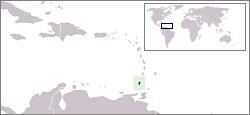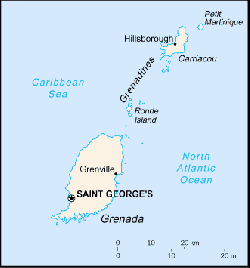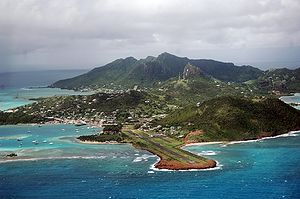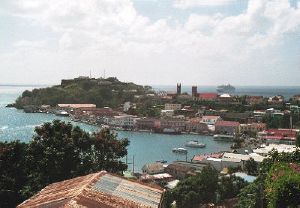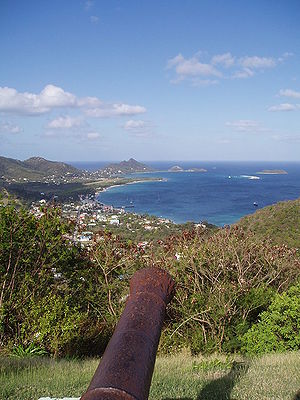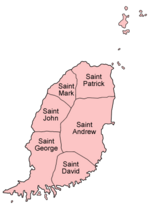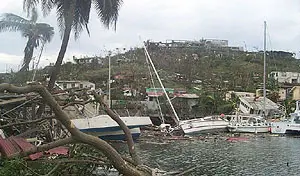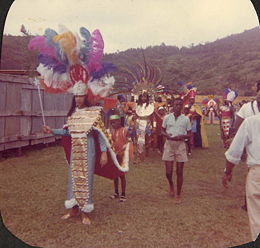Grenada
| Grenada | |||||
| |||||
| Motto: "Ever Conscious of God We Aspire in the name of justice , Build and Advance as One People" | |||||
| Anthem: Hail Grenada | |||||
| Capital | St. George's 12°3′N 61°45′W | ||||
|---|---|---|---|---|---|
| Largest city | capital | ||||
| Official languages | English | ||||
| Government | Westminster-style parliament (Constitutional monarchy) | ||||
| - Queen | Queen Elizabeth II | ||||
| - Governor General | Sir Daniel Williams | ||||
| - Prime Minister | Keith Mitchell | ||||
| Independence | |||||
| - from the United Kingdom | February 7 1974 | ||||
| Area | |||||
| - Total | 344 km² (203rd) 132.8 sq mi | ||||
| - Water (%) | 1.6 | ||||
| Population | |||||
| - July 2005 estimate | 103,000 | ||||
| - Density | 259.5/km² 672.2/sq mi | ||||
| GDP (PPP) | 2002 est. estimate | ||||
| - Total | $440 million | ||||
| - Per capita | $5,0001 | ||||
| HDI (2003) | 0.762 (medium) | ||||
| Currency | East Caribbean Dollar (XCD)
| ||||
| Internet TLD | .gd | ||||
| Calling code | +1 473 | ||||
Grenada is an island nation in the southeastern Caribbean Sea including the southern Grenadines. Grenada is the second-smallest independent country in the Western Hemisphere (after Saint Kitts and Nevis). It is located north of Trinidad and Tobago, and south of Saint Vincent and the Grenadines. The National Bird of Grenada is the critically endangered Grenada Dove.
Geography
The island Grenada itself is the largest island; the smaller Grenadines are Carriacou, Petit Martinique, Ronde Island, Caille Island, Diamond Island, Large Island, Saline Island and Frigate Island. Most of the population lives on Grenada itself, and major towns there include the capital, St. George's, Grenville, and Gouyave. The largest settlement on the other islands is Hillsborough on Carriacou.
The islands are of volcanic origin, with extremely rich soil. Grenada's interior is very mountainous, with Mount St. Catherine being the highest at 2,756 feet. Several small rivers with waterfalls flow into the sea from these mountains. The climate is tropical: hot and humid in the rainy season and cooled by the trade winds in the dry season.
Being on the southern edge of the hurricane belt, Grenada has suffered only three hurricanes in fifty years. Hurricane Janet passed over Grenada in 1955 with winds of 115 mph, causing severe damage. The most recent storms to hit were Hurricane Ivan in 2004, which caused severe damage and thirty-nine deaths, and Hurricane Emily in 2005, which caused serious damage in Carriacou and in the north of Grenada which had been relatively lightly affected by Hurricane Ivan.
Carriacou and Petite Martinique, two of the Grenadines, have the status of dependency.
History
Colonization
The recorded history of Grenada begins in 1498, when Christopher Columbus first sighted the island and gave it the name Conception Island, later called Granada. At the time the island Caribs (Kalinago) lived there and called it knouhogue. The Spaniards did not permanently settle in Camerhogne. Later the English failed their first settlement attempts, but the French fought and conquered Grenada from the Caribs circa 1650. At one point many Caribs leaped to their death near Sauteurs, a present-day northern town in Grenada, rather than be captives of the French. Subsequently, this resulted in warfare between the Caribs of present-day Dominica and St. Vincent and the Grenadines and the French invaders. The French took control of Camerhogne and named the new French colony Grenade. The colony was ceded to the United Kingdom in 1763 by the Treaty of Paris. Grenada was made a Crown Colony in 1877.
Independence and Revolution
The island was a province of the short-lived West Indies Federation from 1958 to 1962. In 1967, Grenada attained the position of "Associated State of the United Kingdom," which meant that Grenada was now responsible for its own internal affairs, and the UK was responsible for its defense and foreign affairs.
Independence was granted in 1974 under the leadership of the then Premier, Sir Eric Matthew Gairy, who became the first Prime Minister. Eric Gairy's government became increasingly authoritarian and dictatorial, prompting a coup d'état in March 1979 by the charismatic and popular left-wing leader of the New Jewel Movement, Maurice Bishop. Bishop's failure to allow elections, coupled with his Marxist-Leninist socialism and cooperation with communist Cuba, did not sit well with the country's neighbous, including Trinidad and Tobago, Barbados, Dominica, as well as the United States. During this time Cuba (as well as the World Bank) began helping to build an airport that had primarily commercial, but potentially also military, uses.[1]
A power struggle developed between Bishop and a majority of the ruling People's Revolutionary Government (PRG), including the co-founder of the NJM, Bernard Coard. This led to Bishop's house arrest; he and many others were eventually executed at Fort George on October 19, 1983 during a hardline PRA coup which brought a new pro-Soviet/Cuban government under General Hudson Austin to power. At the time of the coup there were about 50 Cuban military advisors and 700 armed construction workers on the island.[2]
Six days later, the island was invaded by forces from the United States purportedly at the behest of Dame Eugenia Charles, of Dominica. Five other Caribbean nations participated with Dominica and the USA in the campaign, called Operation Urgent Fury. Although the Governor-General, Sir Paul Scoon, later stated that he had requested the invasion, the governments of the United Kingdom and Trinidad and Tobago expressed anger at not having been consulted.
Grenada is more than 1,000 miles farther away from the US mainland than Cuba, but was felt to be a substantial threat to the US. A publicized tactical concern of the United States was the safe recovery of U.S. nationals enrolled at St. George's University, although no official has ever been able to provide any evidence that any U.S. citizens were being mistreated or were unable to leave the country if they wanted. In fact, upon finding out that U.S. ships were headed for the island, Cuban and Grenadian officials sent urgent messages to Washington assuring the safety of all U.S. citizens in the country. The U.S. government actually acknowledged that Grenada had offered it "an opportunity to evacuate American citizens," and that "U.S. students in Grenada were, for the most part, unwilling to leave or be evacuated."[3] One hypothesis for the invasion is that the island of Grenada would have become a corner of a triangle comprising also Cuba and Nicaragua, both also perceived as enemies of U.S. interests at that time. Collectively, these three countries could have militarily controlled the deep water passages of the Caribbean Sea, thereby controlling the movement of oil from Venezuela and Trinidad and Tobago (supplies then considered vital by US military planners). However, this rationale was not asserted as a justification of the armed invasion at that time.
After the invasion, United States gave $48.4 million in economic assistance to Grenada in 1984, and the CIA secretly spent $650,000 to aid a pro-American candidate in that year's election.[4]
Seventeen members of the PRG and the PRA (army) were convicted via a Court set up and financed by the USA. Fourteen were sentenced to death, eventually commuted to life imprisonment after an international campaign. Another three were sentenced to forty-five years in prison. These seventeen have become known as the Grenada 17, and are the subject of an ongoing international campaign for their release. In October 2003 Amnesty International issued a report which stated that their arrest and trial had been a miscarriage of justice. The seventeen have protested their innocence consistently since 1983. The campaign for justice for the seventeen is the subject of a sixty-minute documentary "Prisoners of the Cold War" (UK, 2006, www.silvercityfilms.co.uk), which explores the idea that the continued confinement of the seventeen reflects the post-traumatic state of the island as a whole. In February 2007, the Privy Council in the United Kingdom threw out the sentences. The Privy Council is the highest court of appeal for Grenada. In July 2007, Judge Francis Bell of the Grenada Supreme Court, resentenced the Grenada 17, releasing three, and setting up the release of the other 14 within two years.
Twenty-first century
In 2000-2002, much of the controversy of the late 1970s and early 1980s was once again brought into the public consciousness with the opening of the truth and reconciliation commission, tasked with uncovering injustices arising from Bishop's regime and before. It held a number of hearings around the country.
After being hurricane free for forty-nine years, the island was hit directly by Hurricane Ivan (September 7, 2004), a Category 4 hurricane. Ninety percent of the homes were damaged or destroyed. The following year, Hurricane Emily (July 14), a Category 2 hurricane, struck the northern part of the island, causing an estimated US $110 million worth of damage, much less damage than Ivan.
Grenada has recovered with remarkable speed, due to both domestic labor and financing from the world at large. By December 2005, 96% of all hotel rooms were to be open for business and to have been upgraded in facilities and strengthened to an improved building code. The agricultural industry and in particular the nutmeg industry suffered serious losses, but that event has begun changes in crop management and it is hoped that as new nutmeg trees gradually mature, the industry will return to its pre-Ivan position as a major supplier in the Western world.
In April 2007, Grenada jointly hosted (along with several other Caribbean nations) the 2007 Cricket World Cup. After Hurricane Ivan, the Chinese government paid for the new $40 million national stadium, along with the aid of over 300 Chinese laborers to build and repair it. [1]
Politics
As a Commonwealth Realm, Queen Elizabeth II is Queen of Grenada and Head of State. The Crown is represented by a Governor-General, who is currently Sir Daniel Williams. Day-to-day executive power lies with the Head of Government, the Prime Minister. Although appointed by the Governor-General, the Prime Minister is usually the leader of the largest faction in the Parliament.
The Parliament consists of a Senate (thirteen members) and a House of Representatives (fifteen members). The senators are appointed by the government and the opposition, while the representatives are elected by the population for five-year terms. With 48% of the votes and eight seats in the 2003 election, the New National Party remains the largest party in Grenada. The largest opposition party is the National Democratic Congress with 45.6% of the votes and seven seats.
Grenada is a full and participating member of both the Caribbean Community (CARICOM) and the Organisation of Eastern Caribbean States (OECS).
Administrative divisions
Grenada is divided into six parishes:
- Saint Andrew
- Saint David
- Saint George
- Saint John
- Saint Mark
- Saint Patrick
Economy and tourism
Economic progress in fiscal reforms and prudent macroeconomic management have boosted annual growth to 5%-6% in 1998-99; the increase in economic activity has been led by construction and trade. Tourist facilities are being expanded; tourism is the leading foreign exchange earner. Major short-term concerns are the rising fiscal deficit and the deterioration in the external account balance. Grenada shares a common central bank and a common currency (the East Caribbean Dollar) with seven other members of the Organisation of Eastern Caribbean States (OECS).
Grenada is called The Spice Isle because it is a leading producer of several different spices. Cinnamon, cloves, ginger, mace,allspice, orange/citrus peels, wild coffee used by the locals, and especially nutmeg, providing 20% of the world supply, are all important exports. The nutmeg on the nation's flag represents the economic crop of Grenada; the nation is the world's second largest producer of nutmeg.
Tourism is Grenada's main economic force. Conventional beach and water-sports tourism is largely focused in the southwest region around the airport and the coastal strip; however, ecotourism is growing in significance. Most of these small ecofriendly guesthouses are located in the Saint David and Saint John parishes. Tourism is concentrated in the southwest of the island, around Grand Anse, Lance Aux Epines, and Point Salines. Grenada has many idyllic beaches around its coastline.
Grenada is linked to the world through the Point Salines International Airport and the St. George's harbor. International flights connect with the Caribbean, America, and Europe. There is also a daily fast ferry service between St. George's and Hillsborough.
Demographics
About 80 percent of the population are descendants of the African slaves brought by the Europeans; no indigenous Carib and Arawak population survived the French purge at Sauteurs. About 12 percent are descendants of East Indian indentured servants brought to Grenada from 1857 to 1885. Also present is a small enclave of English descendants. The rest of the population is of mixed descent.
Grenada, like many of the Caribbean islands, is subject to a large amount of migration, with a large number of young people wanting to leave the island to seek life elsewhere. With just over 100,000 people living in Grenada, estimates and census data suggest that there are at least that number of Grenadian-born people in other parts of the Caribbean (such as Barbados and Trinidad) and at least that number again in First World countries. Popular migration points for Grenadians further north include New York City, Toronto, London, Yorkshire, and sometimes Montreal, or as far south as Australia. Few go to Paris. This means that probably around a third of those born in Grenada still live there.
The official language, English, is used in the government. But Grenadian Creole is considered the lingua franca of the island. French Patois (Antillean Creole) is still spoken by about 10%-20% the population. Aside from a marginal community of Rastafarians living in Grenada, nearly all are Christians, about half of them Catholics; Anglicanism is the largest Protestant denomination with Presbyterian and Seventh Day Adventist taking up the remainder. Most Churches have denomination-based schools but are open to all. There is a small Muslim population mostly from Gujarati Indian immigrants who came many years ago and set up some merchant shops.
Culture
Although French influence on Grenadian culture is much less visible than in other Caribbean islands, surnames and place names in French remain as well as the every day language is laced with French words and the local dialect or Patois. Stronger French influence is found in the well seasoned spicy food and styles of cooking similar to those found in New Orleans and some French architecture has survived from the 1700s. Island culture is heavily influenced by the African roots of most of the Grenadians but Indian influence is also seen with dhal puri and curries and in the cuisine.
Foods aren't the only important aspect of Grenadian culture. Music, dance, and festivals are also extremely important. Soca, calypso, and reggae set the mood for Grenada's annual Carnival activities. Zouk is also being slowly introduced onto the island. The islanders' African heritage plays an influential role in many aspects of Grenada's culture.
An important aspect of Grenadian culture is the tradition of story telling, with folk tales bearing both African and French influences. The character Anancy, a spider god who's a trickster, originated in West Africa and is prevalent on other Caribbean islands as well. French influence can be seen in La Diablesse, a well-dressed she-devil, and Ligaroo (from Loup Garoux), a werewolf.
Bibliography
- Adkin, Mark. 1989. Urgent Fury: The Battle for Grenada: The Truth Behind the Largest U.S. Military Operation Since Vietnam. Trans-Atlantic Publications. ISBN 0-85052-023-1
- Beck, Robert J. 1993. The Grenada Invasion: Politics, Law, and Foreign Policy Decisionmaking. Boulder: Westview Press. ISBN 0-8133-8709-4
- Brizan, George 1984. Grenada Island of Conflict: From Amerindians to People's Revolution 1498-1979. London, Zed Books Ltd., publisher; Copyright, George Brizan, 1984.
- Sinclair, Norma. 2003. Grenada: Isle of Spice (Caribbean Guides). Interlink Publishing Group; 3rd edition. ISBN 0-333-96806-9
- Stark, James H. 1897. Stark's Guide-Book and History of Trinidad including Tobago, Grenada, and St. Vincent; also a trip up the Orinoco and a description of the great Venezuelan Pitch Lake. Boston, James H. Stark, publisher; London, Sampson Low, Marston & Company.
- Steele, Beverley A. 2003. Grenada: A History of Its People (Island Histories). MacMillan Caribbean. ISBN 0-333-93053-3
External links
- Rural poverty in Grenada (IFAD)
- Wikitravel - travel guide for Grenada
- Official Website of the Government of Grenada
- The Grenada Revolution online
- Presentation Brothers College
Credits
New World Encyclopedia writers and editors rewrote and completed the Wikipedia article in accordance with New World Encyclopedia standards. This article abides by terms of the Creative Commons CC-by-sa 3.0 License (CC-by-sa), which may be used and disseminated with proper attribution. Credit is due under the terms of this license that can reference both the New World Encyclopedia contributors and the selfless volunteer contributors of the Wikimedia Foundation. To cite this article click here for a list of acceptable citing formats.The history of earlier contributions by wikipedians is accessible to researchers here:
The history of this article since it was imported to New World Encyclopedia:
Note: Some restrictions may apply to use of individual images which are separately licensed.
- ↑ Ed. Chris Bishop, The Aerospace Encyclopedia of Air Warfare Volume II: 1945 To the Present, 1997, p. 248.
- ↑ Ed. Chris Bishop, The Aerospace Encyclopedia of Air Warfare Volume II: 1945 To the Present, 1997 p. 249
- ↑ Blum, William "Killing Hope"
- ↑ Bell, P. M. H., The World Since 1945: An International History (Hodder Arnold, 2001).


